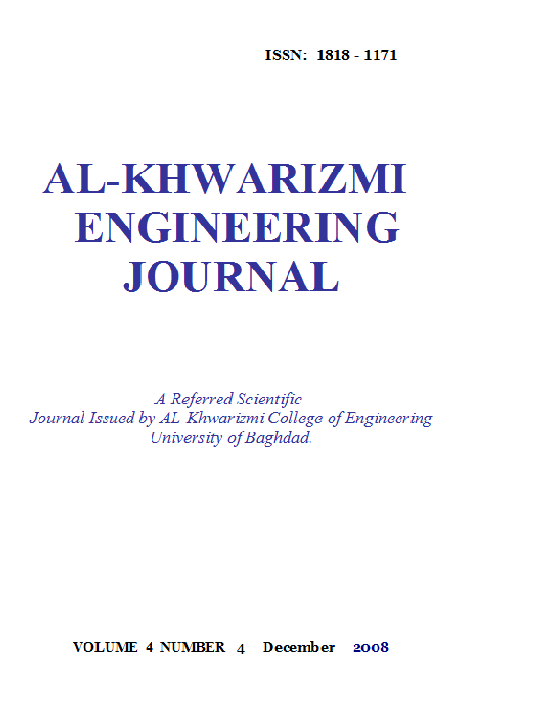Effect of Chloride Ions on the Corrosion Behavior of Al – Zn Alloy in NaOH Solution at Four Different Temperatures
Abstract
This research involves study effect of chloride ions in concentration range (0.01 – 0.50 mol.dm-3) on the corrosion behavior of Al-Zn alloy in basic media of 1x10-3 mol.dm-3 NaOH at pH=11 and four different temperatures in the range (298-313 K). Cathodic and anodic Tafel slopes (bc &ba) and transfer coefficients (αc & αa) were calculated and the results interprets according to the variation of the rate – determining steps. The results also indicate that the chloride ions are bonded chemically in the interface as an initial step of formation of different mixed oxohydroxy – and chloro complexes. Polarization resistance (Rp) is calculates and interprets the different polarization behavior because of addition of chloride ions to the basic media.
Downloads
References
[2] Sundarrajah J., and Ramchari T., Corrosion, 17, 1961, P.39-41t.
[3] Bonewitz R. A., Corrosion-NACE, 29, 1973, P.215.
[4] Bohlmaun E. G., and Posey F. A., Proc. Ist Int. Symp. On Water Desalination, Washington, D.C., October 1961, P.306.
[5] Ahmad Z., and Rashidi S., Proc. Third Middle East Corrosion Conf., Bahrain, May 16-18, 1983, P.229-241.
[6] Nisandoglu K., and Holton H., Corrosion Science, 18, 1978, P.835-849.
[7] Broli A., Holton H., and Sigurdson H., Werkstoffe Und Korrosion, 26, 1975, P.629.
[8] Broli A., and Holton H., 7th Scandinavian, "Corrosion Congress", Trondheim, May 1975.
[9] J. Janko Wisk and R. Juchniewicz, corrosion Science, vol.20, P.841, (1980).
[10] Uhlig H. H., "Corrosion and Corrosion Control", Wiley, New York, (2000).
[11] Sherir L.L.,"Corrosion",Metal/Environment Reactions, second ed., 1, 1976, P.4-12.
[12] Saleh J. M., and Al-Haidari Y. K, Bull. Chem. Soc.(Jpn), 62, 1989, P.1237.
[13] Al-Shamma L. M., Ph.D Thesis, College of Science, University of Baghdad, October 1998.
[14] Al-Saadie K.A.S., Ph.D. Thesis, College of Science, University of Baghdad, October 1997.
[15] Goodrad H., Jepson W., Bathwell M. and Kane R., "The Corrosion of Light Metals", (Wiely, New York), P.1-218, (1967)
[16] Stern M. and Grary A.L., J. Electrochem. Soc., vol.56, P.104, (1957).
[17] Stern M. and Weisert E.D., Proc. Am. Soc. Test Master, vol.59, P.1280, (1959).
[18] Sykes J.M., Brit. Corrosion J., vol.25, P.176, (1990).
[19] Bockeris J. O. M., and Reddy A. K., "Modern Electrochemistry", Press, New York, 1970, P.176.
[20] Fontana G., and Green D., "Corrosion Engineering",McGraw–Hill, New York, (1978).
[21] Tomesanyi L., Varga K., Bartik I., Horanyi G., and Maleczki E., Electrochimica Acta, 34, 6, 1989, P.855-859.
[22] Zaki A., ANTI-Corrosion, November 1986, P.4-11.
Downloads
Published
Issue
Section
License
Copyright: Open Access authors retain the copyrights of their papers, and all open access articles are distributed under the terms of the Creative Commons Attribution License, which permits unrestricted use, distribution, and reproduction in any medium, provided that the original work is properly cited. The use of general descriptive names, trade names, trademarks, and so forth in this publication, even if not specifically identified, does not imply that these names are not protected by the relevant laws and regulations. While the advice and information in this journal are believed to be true and accurate on the date of its going to press, neither the authors, the editors, nor the publisher can accept any legal responsibility for any errors or omissions that may be made. The publisher makes no warranty, express or implied, with respect to the material contained herein.












